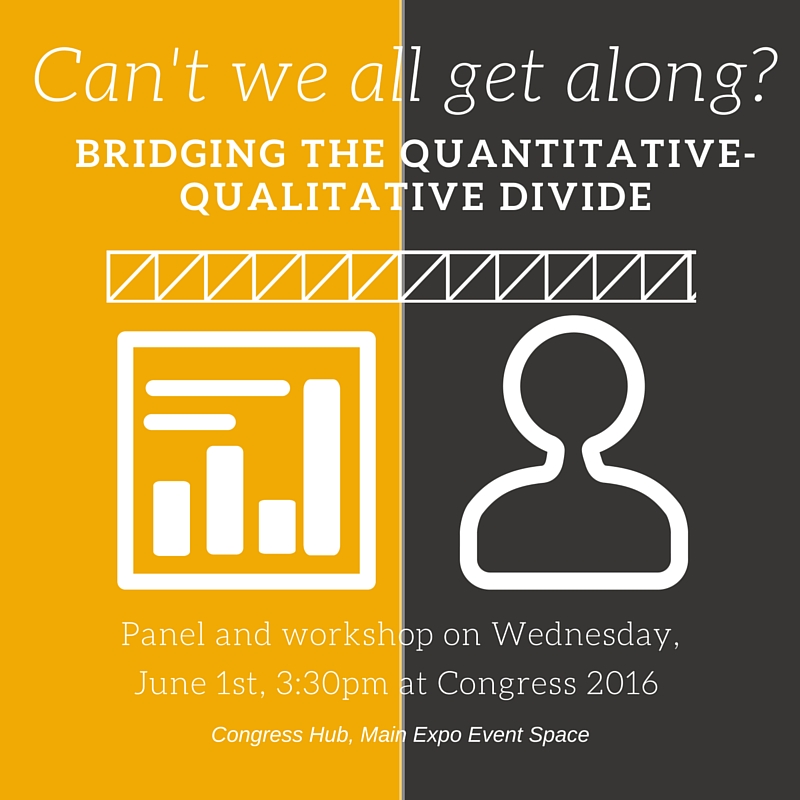Some years ago, two great research traditions arose in social and behavioral science: talking to people and gathering data and numbers about people. A hybrid tradition, which goes by various names but which we’ll call ‘mixed methods,’ arose in the interstices of those qualitative and quantitative approaches.
But something else arose in those traditions: partisans of each method. The advocates of one tradition could at times have a ‘take-no-prisoners’ attitude toward practitioners of the other one—a divide that grew as the volume of data available to quants grew exponentially. This “methodological tribalism,” as Michèle Lamont and Ann Swidler have called it, is an even more niche divide in social science and less public at times if no less real.
“I’ve endured this distinction for so long that I had begun to take it for granted, a seemingly fixed property in the firmament of social science data collection and analysis strategies. However, I’ve never been happy with the distinction and about a decade ago, began challenging people who label themselves this way,” wrote sociologist Howard Aldrich in a piece for the American Sociological Association subtitled “Why social science should stop using the qualitative/quantitative dichotomy.” He continued, “I was puzzled by the responses I received, which often took on a remorseful tone, as if somehow researchers had to apologize for the methodological strategies they had chosen.”
It doesn’t have to be that way, as a Career Corner workshop titled “Can we all get along? Bridging the quantitative-qualitative divide” will discuss on the afternoon of June 1 at Congress 2016. The goal of the workshop isn’t to debate the value of the three approaches, but to help researchers find the right approach (or approaches) for their work and get some practical tips on using those methods from an expert practitioner of each tradition: quantitative, qualitative and mixed.
The session is hosted by SAGE Publishing, which has for years been a global leader in disseminating and innovating on research methods.
Experts at the session will include:
Alex Clark, Advisory Board Chair of International Institute for Qualitative Methodology, and professor and associate dean of research nursing at the University of Alberta. Clark is the editor of the Institute’s International Journal of Qualitative Methods.
Michael Young, a professor in the School of Humanitarian Studies at Royal Roads University in Victoria, British Columbia since 2008. Young has described his mixed methods research on homelessness in Inuvik in the North West Territories in a recent SAGE Research Methods case study highlighted at the MethodSpace website.
The 90-minute session starts at 3:30 p.m. at the Main Expo Event Space in the Congress Hub. Before the event, join the experts at the SAGE booth (#16) in the exhibit hall for one-on-one questions and a SAGE-hosted reception.
Different methods exist for different purposes, and in some small way we hope participants leave seeing all three methods having a role. We leave the final word to a passionate advocate for quantitative social science, Harvard’s Gary King, who in an article titled “Restructuring the Social Sciences” addressed the value in all approaches:
“Fortunately, social scientists from both traditions are working together more often than ever before, because many of the new data sources meaningfully represent the focus and interests of both groups. The information collected by qualitative researchers, in the form of large quantities of field notes, video, audio, unstructured text, and many other sources, is now being recognized as valuable and actionable data sources for which new quantitative approaches are being developed and can be applied. At the same time, quantitative researchers are realizing that their approaches can be viewed or adapted to assist, rather than replace, the deep knowledge of qualitative researchers, and they are taking up the challenge of adding value to these additional richer data types.”

